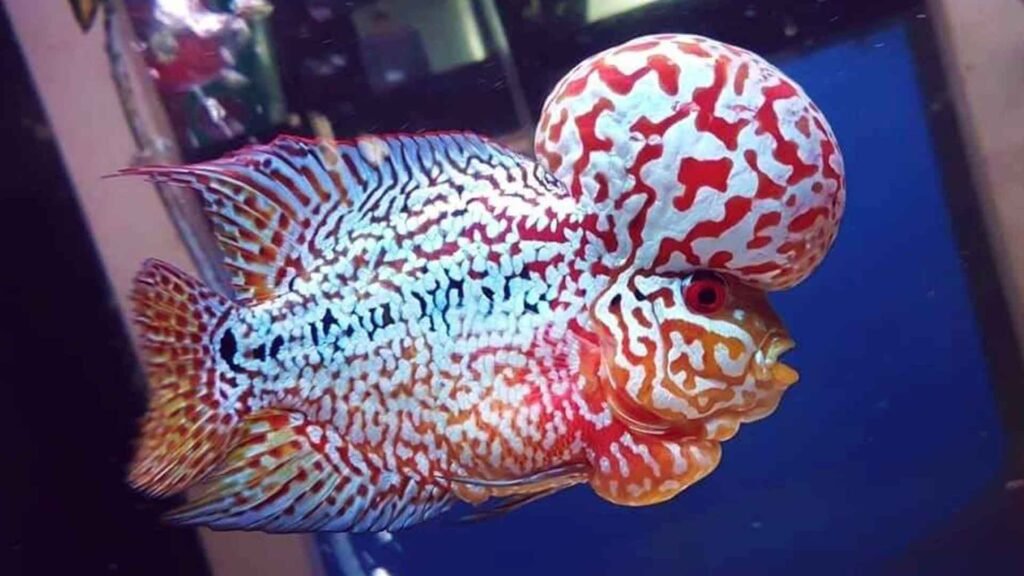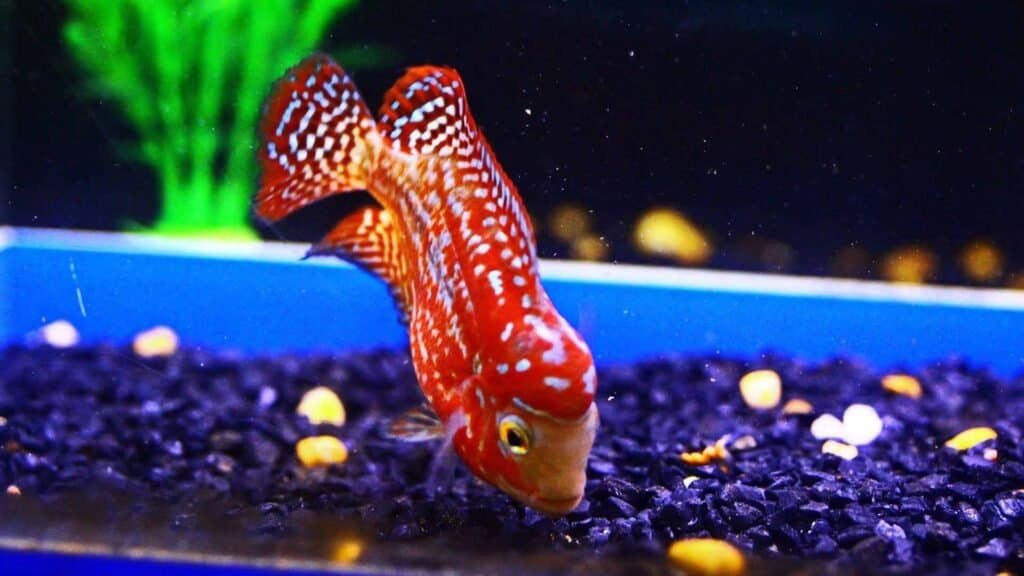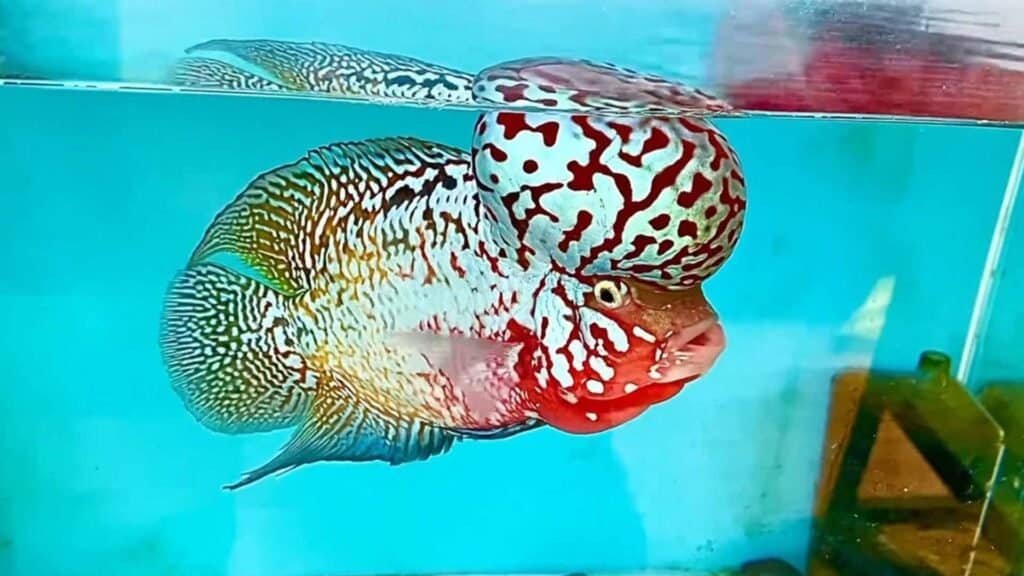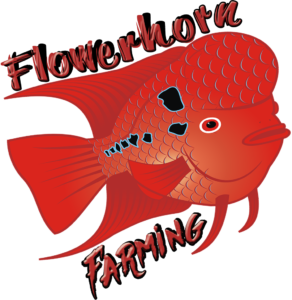Article Contents
The Flowerhorn cichlid is one of the most interesting and unique fish around. The gorgeous colors and beautiful looks of this fish have catapulted it to “superstar” status in the world of fishkeeping. In Asia, the Flowerhorn cichlid is considered to bring good luck to its owners according to Feng Shui. It is believed that the larger the nuchal hump or Kok of the Flowerhorn, the more good luck the fish will bring. This belief is based on the opinion that the Flowerhorn with a large nuchal hump makes it resemble the Chinese God of Longevity.
About the Flowerhorn Cichlid
Flowerhorn cichlids are gorgeous and unique. They are called Flowerhorns because of the distinct markings on the side of their body resembling Flowers. The horn portion of their name is a result of the prominent “nuchal hump” or “Kok”.
Similar to blood parrot cichlids, Flowerhorn cichlids are hybrids that have been created by man. Since Flowerhorns are man-made, they are domesticated aquarium fish and are not found in the wild, unless they have been released by their owners. The Flowerhorn cichlid originated in Asia by way of Thailand, Malaysia, and Taiwan but they have spread all over the world with the exception of Australia where they are banned.
Origin and History of the Flowerhorn Cichlid
Unlike the blood parrot hybrid, the creation of the beautiful Flowerhorn was not by chance. It is a man-made creation and the breeding of the Flowerhorn cichlid can be traced back to 1993. The fish that were found in western Malaysia with protruding heads, also known as “Kaloi” meaning “warships”, were considered very beautiful. These fish with long tails and protruding heads were considered to bring good luck by the Taiwanese.
In 1994, Trimac cichlids and red devil cichlids were imported to Malaysia from Central America and the blood parrot cichlid was brought to Malaysia from Taiwan. These fish were bred together and the Flowerhorn cichlid was created.
The “Human Face Red God of Fortune” was crossbred with blood parrots in 1995 and a new breed was created which was named “Five Colors God of Fortune”. This beautiful fish with its mesmerizing colors became very popular. The process of selective breeding carried on through the years, when in 1998, the “Seven Colors Blue Fiery Mouth”, which was also called Greenish Gold Tiger, originating from Central America, and the Taiwanese fish, Jin Gang Blood Parrot were crossbred. The result of this breeding was the birth of the first-generation Hua Luo Han Flowerhorn cichlid hybrids. After this, several other Flowerhorn hybrids were created.
Initially, when the Luo Hans was brought to the US, there were two breeds of cichlids, the golden base and the Flowerhorn. The Flowerhorn cichlids were available in two types – Flowerhorns with pearls i.e. with silvery-white spots and the type without the pearls. The Flowerhorn with pearls, called Zhen Zhu became more popular than the ones that didn’t have the pearling. The golden base also was available in two varieties, the ones whose color faded and the ones that remained golden yellow, without fading.

Around 1999, the American market had four varieties of Flowerhorn cichlids – pearl scale Flowerhorns or Zhen Zhu, regular Flowerhorns without pearls, faders, and golden Flowerhorns. Commercial breeding of Flowerhorns became rampant and the origin, parentage, and names of the fish were difficult to keep track of.
The Kamfa flowerhorn, which was a hybrid between any kind of flowerhorn crossbred with any variety of parrot cichlid or with the Vieja species was born around the year 2000-2001. These fish had wrapped tails, short mouths, sunken eyes, and bigger nuchal humps. The Zhen Zhu varieties were then bred to be more colorful and develop faster in comparison to the Kamfa variety of Flowerhorns.
There are even more varieties of the Flowerhorn cichlids created with patterns resembling Chinese letters or the ones with pink heart-shaped patterns that fetch thousands of dollars even today.
The Appearance of the Flowerhorn Cichlid
Flowerhorn cichlids are characterized by thick oval bodies. They can grow to a length of 12-16 inches. The scales of the flowerhorn have varied colors and hues and they can range from bluish to metallic green with pinks and reds on the front half of the body. Most of the Flowerhorn varieties have black horizontal markings on the body.
The dorsal and anal fins of the Flowerhorn cichlid are pointed and long and the caudal fin has a spade-like rounded appearance. Like other cichlids, Flowerhorn cichlids also have their regular teeth, along with a set of well-developed pharyngeal teeth, located in their throat. They have one nostril on each side of the head. Flowerhorn cichlids usually have a lifespan of about 8-10 years.
The most amazing characteristic of the Flowerhorn cichlid is its changing coloring and patterns that keep changing until the fish becomes a fully mature adult. If you like a particular color or pattern of fish, you must not buy a juvenile or a fish that is not fully mature as these features of the fish are most likely going to change as it matures. And since the appearance of juveniles is rather uncertain, they are much cheaper than fully-grown adult flowerhorns.
When buying an adult Flowerhorn cichlid, make sure that you look for the following “Flowerhorn Fish Standards” i.e. the coloration, body shape, pearl scales, well-developed nuchal hump, black horizontal markings on the body, erect fins and tails, and alert eyes.
Suitability for the Aquarium
Flowerhorn cichlids are very hardy fish that are easy to care for. They grow up to 12-16 inches (31-41 cm) in length and need a large tank with at least 55 gallons of water. If you plan on keeping other fish in the tank, then you will need a much larger tank.
Flowerhorn cichlids spend most of their time swimming out in the open but also love to have a gravel substrate and rocks for digging and hiding. So, make sure that you leave plenty of space in your aquarium so that your Flowerhorn can thrive. They love to dig the aquarium bed and so if you have any decorations or rocks in the tank, they should be selected carefully so that they don’t fall over and potentially harm the fish. If you are planning to decorate your aquarium with some live plants, you should call an audible, as your flowerhorn will eat any live plants placed in the aquarium.

It is best to keep the Flowerhorn single in the aquarium as the “centerpiece”, as they are quite aggressive and territorial and not really suited for community living unless the tank is extremely large (with more than 200 gallons of water). Also, if you have other fish in the tank along with the Flowerhorn, do check them regularly for signs of stress or injury that may be caused by the Flowerhorn cichlid. If you insist on having other fish in the tank, it’s a good idea to decorate the aquarium in such a way that you provide all the fish places for hiding and escaping danger. This will also provide distinct territory and keep the fish out of each other’s line of sight which will dramatically reduce aggression.
Aquarium Care
Flowerhorn cichlids are hardy fish and are not very sensitive to water conditions. However, to keep your Flowerhorn healthy, it is recommended that you follow a strict aquarium maintenance schedule. Flowerhorns are messy eaters and so your tank should have effective filtration. Depending on how much the fish eats, the aquarium should be cleaned bi-weekly or once a month. The panes should be kept algae-free and the substrate should be vacuumed properly to remove fish waste. While cleaning your flowerhorn tank, it is a good idea to watch out for any signs of aggression and keep your hands and fingers safe, as the Flowerhorn can give you quite a nasty bite.
Feeding
Flowerhorn cichlids are carnivores and have a large appetite. They can eat any kind of food that is meaty and protein-based. They can eat live, fresh or frozen food and also eat flake foods and fish pellets. However, you should take care to feed your Flowerhorn a wide variety of high-quality foods. You can feed them a mixture of cichlid pellets, frozen blood worms, krill, earthworms, shrimp, fish, crickets, nightcrawlers, vitamins, and supplements with enhanced carotene that will help to improve and augment their coloring. You can feed your Flowerhorn 2-3 times in a day but try to avoid leaving uneaten food in the tank that will quickly pollute the aquarium water.
Breeding
Despite being a hybrid, some flowerhorns are fertile and can breed. When you are breeding the flowerhorn cichlid and you are looking for some specific patterns or colors, then make sure to take into consideration the ancestry of the fish you’re breeding, or you may end up with fry that lacks the characteristics you are aiming to get.
During the process of breeding the Flowerhorn cichlid, make sure that you have plenty of places for the female to hide as the male can get aggressive and attack the female. If the male flowerhorn becomes too aggressive, then put a divider in the tank via which the male and female can interact without the male getting to the female. Place a flat stone next to the divider and remove any other potential objects which could be used by the female for laying eggs. Doing this will force the female Flowerhorn to lay her eggs on the stone (or the aquarium glass), where they can be fertilized. Once eggs are present it’s a good idea to move the eggs as close as possible to the male so he can do his part to fertilize the eggs.

The new parents typically both guard the eggs fiercely. Be careful to watch the Flowerhorn pair closely during this time period. Sometimes, the male may become possessive over the fry and attack the female to keep her away. It’s not uncommon for the female Flowerhorn to be killed so again WATCH the pair closely. If aggression starts to get out of control then it is best to remove the female from the tank. The fry of the Flowerhorn cichlid are resilient and care for themselves independently of their parents. You can feed the newly hatched fry with brine shrimp and after a week or two, the fry can be fed with flake foods or crushed pellets.
Differentiating Between the Sexes
Generally, male flowerhorns are larger than females. The males have a more pronounced nuchal hump, a thicker mouth and they have more vivid and brighter coloring. Female flowerhorns usually have black colored dots on their dorsal fins and the males have longer dorsal and anal fins. Female flowerhorns have an orange belly, especially when they are ready to breed. A sure method to determine the sex of the Flowerhorn cichlid is to vent them.
Diseases
Flowerhorns are usually bred very carefully without any crossing between bloodlines. Due to this meticulous breeding regime, Flowerhorn cichlids are not plagued by any major ailments like the other cichlid hybrids.
However, Flowerhorns are susceptible to common fish diseases, especially if the water is not frequently changed. A common problem that affects Flowerhorns is Ich, which can be treated by raising the temperature of the tank to 86° F and if the fish is still not cured, then copper-based medication must be administered.
Flowerhorns can also get an intestinal disease that can be treated by administering metronidazole. Flowerhorn cichlids are also prone to hole-in-head disease and digestive blockages that can be averted by maintaining the cleanliness of the water and a proper diet. Flowerhorn cichlids are also susceptible to problems like skin flukes, fungal infections, bacterial infections, and parasitic infestations like worms, protozoa, etc. Because of the multitude of potential health hazards examine your fish daily to catch potential diseases early which will prevent death.
Varieties of Flowerhorn Cichlids
Some of the popular flowerhorn varieties are:
Golden Monkey
Also, known as Kamalau or Good Fortune, this flowerhorn was bred in Malaysia. The Golden Monkey is not a mixed hybrid, but an original Luo Han fish. The Golden Monkey is quite expensive. In a Malaysian exhibition in 2009, a Golden Monkey was sold for $600,000.
Kamfa
The breed has been created from the Luo Han and it has yellow, white or red sunken eyes, fantail, and head bump. The Kamfa is larger and has a more squarish body when compared to the Zhen Zhu.

Zhen Zhu or Pearl Flowerhorn
These Flowerhorns came subsequent to the Kamfa and have also originated from the Luo Han. Zhen Zhu has a large mouth, rounded tail, prominent head hump, and red protruding eyes. The characteristic feature of these fish is their distinctive pearling.
Golden Base (Faders)
Also known as Golden Trimac, these Flowerhorn cichlids are called faders as their color completely fades and they completely turn black when they are juveniles. As they grow older, the black color slowly fades and the fish become a vibrant red or yellow.
Some of the other varieties of flowerhorn cichlids are Red Texas Cichlid, King Kamfa, Kamfamalau, Thai Silk, Golden Apple, Indo Malau, Tan King, etc.
Flowerhorn cichlids are indeed stunning, captivating fish, fish that you must bring home if you are an avid fish lover.
